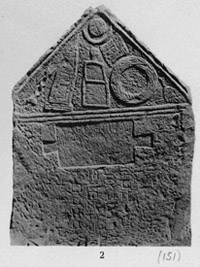- Introduction
- Further information

Libyco-Berber is a writing system used for the indigenous language(s) of Northwest Africa, from the Canary Islands to modern-day Libya, during the Classical period. It is a consonantal alphabet (or abjad), apart from one sign which can apparently be used to mark word-final vowels. The direction of writing is most commonly bottom-to-top or right-to-left. There is significant variation in the script, leading many authorities to propose a division between "eastern" (Numidian, Massylian) and "western" (Masaesylian) varieties (eg Chabot 1940, Galand 1988); however, this distinction is contested (Pichler 2007). The script is “geometric” in form, with letters consisting almost exclusively of straight lines and circles.
Libyco-Berber was used for official inscriptions, concurrently with Punic, by the Numidian kingdom, particularly at Dougga. However, most surviving texts are funerary inscriptions on stone stelae, recording the name and ancestry of the deceased (X w-Y "X son of Y") and little else. A number of hard-to-date graffiti on rocks in this script are also found.
Many Libyco-Berber letters, as well as the principle of writing only consonants, appear to derive from the Phoenician or Punic script, although other letter forms have no plausible Phoenician source and appear to be local inventions. (A number of other hypotheses have been advanced for its origin, including independent construction, South Arabian influence, and even Ugaritic influence, but those appear much less plausible). The apparent fact that final vowels are marked suggests Punic origin, or at least influence, and the Numidian kingdom of Masinissa around the second century BC has been suggested as a plausible point of origin (Kerr 2010). However, iconographic arguments have been made that some inscribed stelae from Kabylie predate Masinissa by a century or more (Laporte 1991), and some rock inscriptions (notably at Azib n'Ikkis in Morocco) have been argued to date to a considerably earlier period on the basis of the style of the rock art accompanying them (Camps 1974). If the latter dating is accepted, then the origin of the script must be pushed back, to the ninth century BC or so (Pichler 2007). The only precisely dated inscription known is from the tenth year of the Numidian king Micipsa's reign, about 138 BC. A number of Punic and Latin bilingual texts are found, attesting to its use in the Roman period, and on the southern slopes of the Atlas Mountains the script seems to have remained in use as late as the 5th century AD (Camps 1986). In contrast, no Arabic bilingual texts have been found, and no Libyco-Berber inscriptions have been identified from the Islamic period; the Libyco-Berber script is therefore presumed to have fallen into disuse in North Africa proper before the arrival of the Arabs. However, a divergent variant of the Libyco-Berber script survived in the Sahara, developing with some changes into the Tifinagh script still used by some Tuareg groups. In the late 20th century, Kabyle Berber activists invented a new version of the script, in which all vowels were marked and the direction of writing was left-to-right; adaptations of this are now used for educational purposes in Morocco and, to a lesser extent, in Algeria.
The decipherment of this script by F. de Saulcy in 1843 was made possible by comparison of personal names in bilingual inscriptions giving Punic equivalents; Latin bilinguals have also been discovered. The value of a few characters not attested in these bilinguals, particularly some of those associated with the "Western" variant of the alphabet, remains uncertain.
Go to the online resources.
Online resourcesPhoto Gallery
List of symbols
Examples of writing
Bibliography
Map of places
